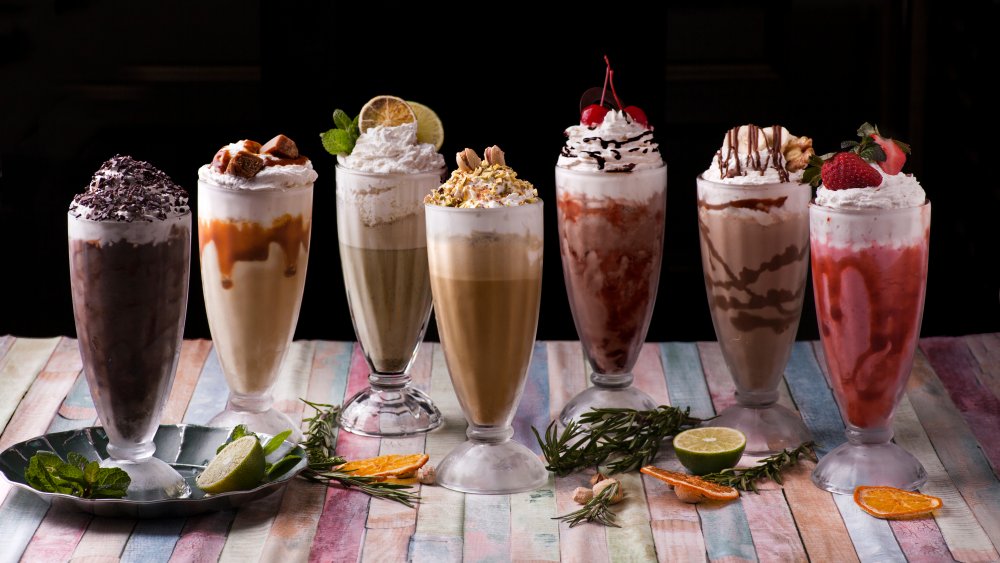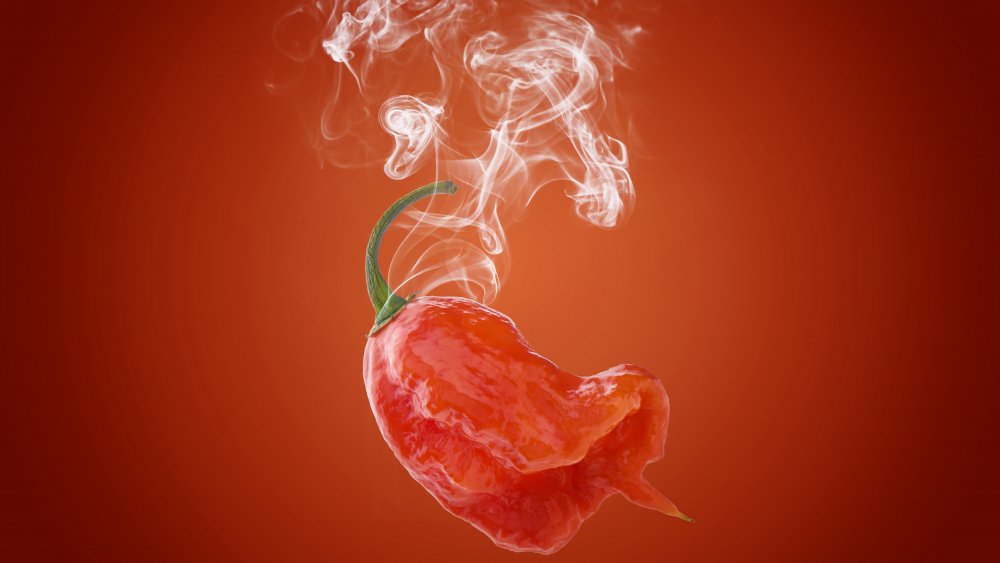What Food Challenges Actually Do To Your Body
Food challenges are a relatively new thing, but they've been around for longer than you might expect. The first (likely) belongs to the Crown Candy Kitchen, who challenged patrons to drink five 24-ounce milkshakes in less than half an hour. As a reward for completing it, you'll get free milkshakes, a T-shirt, and your picture on their wall of fame. They've been around since 1913, but it wasn't until Adam Richman kicked off Man v. Food that it became something insanely popular — and something the everyman could try.
Today, there are all kinds of eating challenges. If you don't fancy trying to scarf down a table full of milkshakes or an ice cream sundae bigger than your head, there's always giant burritos, spicy chicken wings, massive pancakes, or towers of oysters. Whatever the food, success — or sometimes, even failure — comes with a price.
Humans aren't meant to consume that much food in a single sitting, and if you've ever thought it's got to have some adverse effects on not just a digestive tract, but the whole body, you're correct. What kind of effects? Buckle up, because this is going to get real.
Your stomach fills up fast during food challenges
Watching anyone — professional or amateur — pack away an insane amount of food during any challenge brings up an important question: where the heck is it all going? According to Healthline, the average human stomach is 12 inches long, six inches wide at the widest point, and can stretch to comfortably hold about a quart of food. That's not much when you're talking about scarfing down dozens of hot dogs for a food challenge, so what happens to your stomach during a food eating const, and how do competitive eaters keep going?
Chronic overeating can stretch a person's stomach to allow them to eat much more, and when it comes to the professionals, that's exactly what they do. Take world-famous speed eating champion Matt Stonie, for example. He told Thrillist that his stomach has between a 16- and 20-pound capacity, and just think about how much that really is.
They get stomachs that way by constantly overeating. Competitive eater Michelle Lesco told Women's Health that she trained for events by eating foods in a quantity that would help stretch her stomach. That includes things like a gallon of chocolate milk or four liters of soda, chugged in a matter of minutes. She went on to say that a properly stretched stomach allows her to shove food into in a way she likened to "pouring sand into a bucket instead of into a deflated balloon."
Normal people might burp or vomit during a food challenge
Developing the ability to eat obscene amounts of food for food challenges is also about muscle control. According to University of Pennsylvania professor of gastroenterology Dr. David C. Metz (via the Huffington Post), relaxing the muscles around the stomach is key. Normally, the muscles around your gut increase the pressure on your stomach as it fills. That's why you burp and, in extreme cases, might vomit after eating or drinking way too much — something that happens often during amateur eating competitions. But in order for competitive eaters to be really successful, they need to relax those muscles that force the vomiting and nausea reflex in most people.
Other muscles are affected during food challenges, too. University of Pennsylvania researchers studied (via Popular Science) just what's going on inside the digestive tract of eaters in mid-competition. While most average people will stop when they feel full, those that are really good at it showed little to no peristalsis — that's the constant movement of the digestive tract, which moves food down along the line. They're not quite sure what's going on here, but it seems to suggest that in order to be really good at food challenges, your body needs to be tricked into never feeling full.
Your brain will tell you to stop eating during a food challenge
If you've ever sat down to, say, try to finish a table-sized pizza to get your picture on a wall of fame, there's something working against you: your nervous system.
Specifically, the vagus nerve. When you eat and eat and eat, your stomach isn't necessarily the one that tells you that you really need to stop now, thank you very much. When you're full, that triggers the vagus nerve to send a message to your brain to tell you to stop. It's not just a discreet message, either, it's part of what triggers feelings of discomfort, nausea, and — if you don't listen to it — vomiting. Forbes calls it the satiety reflex, and it's what plays a huge part in food challenge failures. If you're participating in a food challenge, your brain will probably tell you to stop pretty quickly.
It's also part of what competitive eaters train themselves to ignore by eating progressively larger and larger amounts. But Scientific American says that there may be a way for the every-day competitor to hack the system. Researchers say some foods — particularly desserts — override our satiety reflex, trigger your brain's reward system, and lead to what's called "hedonic hunger," or eating just for the sake of eating. It's why you eat the whole pint of ice cream instead of just a scoop, so if you're looking for that food challenge to ace, go for something sweet and let your brain work with you, not against you.
Your stomach will swell during a food challenge
When researchers from the University of Pennsylvania published the results of their study that looked at the differences between a professional competitive eater and an amateur, they noted something strange.
When the "control" subject started eating hot dogs, he ate seven before reporting that he was feeling so sick that he was done eating. When he was finished, he lifted his shirt and researchers recorded there was no visible change in his shape.
Then, the competitive eater. Ten minutes and 36 hot dogs into the test, internal scans showed his stomach had expanded to the point where he was risking gastric perforation. The decision was made to stop the test — even though he protested that he could keep going. When he lifted his shirt, researchers found his abdomen had protruded so much it looked like he was "developing intrauterine pregnancy." They lamented not being able to follow him in the days afterward, but he did say that over several days of not eating, his abdomen would slowly return to normal.
The lesson here might be that if you're planning on winning a food challenge, you should probably have a bigger pair of pants stashed away somewhere. You're going to need them.
That cheering crowd makes food challenges easier, but just for men
Food challenges are often a social sort of thing. From professional contests to Man v. Food to the spicy wing challenge at your favorite dive bar, anyone taking on a challenge is probably going to be cheered on. It turns out that cheering is important — at least, for men.
Researchers from Cornell University conducted a study to see what influence the presence or absence of a cheering crowd had on competitors' ability to eat. They found something incredible: Cheering spectators encouraged men to eat more, and women to eat less.
What's going on here? When they talked to study participants, they found that women described competitive eating in front of an audience as making them feel embarrassed and self-conscious, which limited the amount they were able to eat. Men, on the other hand, said they were encouraged by the cheers and the idea of performing feats of gluttony for a crowd, and that made them capable of eating more than they could have if they weren't in front of an audience. The right mindset is important!
Food might get stuck during food challenges
If you've watched competitive eaters in action, you might notice that many have a tendency to jump as they're eating. There's a practical reason for that, says Michelle Lesco (via Women's Health). When you're trying to beat the clock, you're — of course — eating fast. That can make the food build up where you don't want it to, and jumping helps keep the food moving down and not backing up in the esophagus.
Yuck.
Matt Stonie told Thrillist that standing straight also helped open up the abdominal cavity to keep things moving in the right direction, because all that food tends to get lodged in the upper stomach. Getting it to move downward isn't always easy, and that means a lot of shaking and wiggling to pack food into the bottom of the stomach. Are you trying your hand at food challenges while you're sitting on a bench at a restaurant? You just might be sabotaging yourself, and now you know.
Dairy food challenges overwhelm your digestive ability
Which seems like it would be the worst kind of challenge? Quantity? Spiciness? How about dairy challenges, like ice cream and milkshakes? Let's put it this way: when Adam Richman tried the Crown Candy Kitchen's five milkshake challenge, it ended poorly. Very poorly. In the bathroom.
According to what Matt Stonie told Thrillist, drinking milk isn't like drinking water. It's more like eating solid food, because it doesn't pass through the system nearly as quickly.
Stanford's Dr. Connor O'Brien got a little more specific, saying there's a reason milk and dairy challenges are so bad, and that's because of the lactose. Dairy challenges essentially overload your ability to digest lactose — even if you're not lactose intolerant, there's only so much your body can process. Ingest more than that, and the lactose gets pushed into the colon, the bacteria there digests it and it multiplies. The consequences are harsh: you end up with terrible gas and diarrhea. Why does this happen? Milk products, he says, digest so slowly because there are a lot of nutrients and compounds in there that your body needs to take care of, and when you drink or eat too much of it, you're going to be in for a world of hurt. And so is the nearest bathroom.
Spicy food challenges can send you to the hospital
First, the good news. According to the BBC, there doesn't seem to be much in the way of scientific evidence that scarfing down Carolina Reaper sauce-covered wings during a food challenge is going to do lasting damage... most of the time. But it will make you think it is, and here's what's going on.
The capsaicin in the hot peppers are triggering pain receptors, and sending signals to the brain that say you're being burned... even though you're really not. The responses triggered — including sweating, retching, and inflammation — are some of the same responses that happened when you, say, burn your hand on a hot pan.
And as we're developing hotter and hotter peppers, reactions are getting extreme. In 2014, two reporters were sent to the hospital after trying to eat the dubiously-named XXX Hot Chilli Burger, suffering from severe stomach pains.
Then, in 2018, The Guardian reported on the unfortunate side effects that came after one man ate a Carolina Reaper. He ended up in the hospital after the pepper triggered a series of something called thunderclap headaches. They're headaches that occur in sudden, short bursts of extreme pain, and in his case, the hot pepper had triggered the narrowing of the blood vessels in his brain, which in turn started the headaches. It was reversible, but his case was also linked to several other cases where hot peppers caused the narrowing of arteries and ultimately heart attacks.
Your body can literally drown itself during food challenges
Many food challenges allow you to drink water while you're trying to finish, and competitive eaters say it's a valuable tool. Competitive eater Joey Chestnut has said that he would drink gallons of water in training and during contests, all to help compact food in his stomach and get it going down faster. But according to the American Council on Science and Health, that's ridiculously dangerous.
Drinking too much water over a short amount of time — like the time a food challenge takes — can lead to water intoxication. It's essentially a condition where there is so much water in the body that levels of other vital elements — particularly sodium — drop too low, and it can be deadly.
Low sodium is called hyponatremia, and the Mayo Clinic says it's often caused by drinking too much water (although there can be other causes). It can lead to confusion, fatigue, muscle weakness and spasms, headaches, vomiting, seizures, and even coma. In 2007, a woman named Jennifer Strange was participating in a challenge to see who could drink the most water without relieving themselves, and after drinking two gallons (and coming in second), she died of water intoxication.
Food challenges take a toll on your jaw, too
Competitive eating champ Randy Santel says (via Food Challenges) that stomach capacity is only part of the food challenge struggle. Successful eaters need some serious jaw strength, too, and some challenges — think steak and pizza — depend on it. He recommends building up strength and endurance by chewing gum and training with chewy foods, but it turns out this can all have a troubling side effect.
Competitive eater Takeru Kobayashi found that out the hard way when he had to bow out of Nathan's Famous hot dog eating contest in 2007. According to People, the 29-year-old lamented that he had been diagnosed with arthritis of the jaw, and he was unable to open his mouth more than a finger's width. Medical News Today says it's no small inconvenience, and can interfere with everyday life, sleep, and even cause further dental problems. Given that they also say being mindful of damaging chewing habits is key to treatment, it's safe to say that competitive eating and food challenges would be off the table.
Being skinny helps your body process during food challenges
Take a look at a lineup of professional competitive eaters, and you'll notice something surprising: most of them are very, very thin. There's actually a practical reason for that, and Mental Floss says it doesn't have anything to do with a need to keep fit when they're not eating thousands upon thousands of calories in a single sitting.
When someone shoves an abnormal amount of food down their throat in a very short amount of time, it causes the stomach to expand — professional or amateur. And it needs room to expand. The heavier the person, the more fat they're carrying in their abdomen. The expanding stomach needs to push against that fat, and that's going to limit what fits. A thin person has less fat and more of a chance for their stomach to expand more comfortably, and that adds up to a bit more space for food. Every bit counts when you're taking on a food challenge, so being skinny is about more than just overall health.
The food challenge will leave you feeling bad long after it's over
The physical effects of taking on a massive food challenge don't end with the competition, either. According to Women's Health, eaters of all levels can expect some suffering after they finish, whether they win or check out.
Competitive eater Michelle Lesco says the effects depend on the food. If it's something salty — like hot dogs — you can expect a day or two of feeling extremely, uncomfortably bloated. She also reports being exhausted following competitions, and says the greasy foods will definitely leave you with a mouthful of grease that can make you feel sicker than the actual food.
Gastrointestinal distress is also common, and there's a catch: because professional competitive eaters train with massive amounts of food pretty regularly, they're also training their bodies to deal more efficiently with the consequences. And that means the civilian who thinks it's an awesome idea to try a food challenge for the first time is going to suffer way more than a professional would. That's food for thought.
Long-term effects of food challenges are still largely unknown
It's also worth noting that since food challenges are still a relatively new phenomenon in the grand scheme of things, no one's quite sure what the long-term effects they're going to have on the people who regularly do them. As Matt Stonie told USA Today, "A lot of us don't know what we're doing. We're just experimenting. Sometimes people go a little gung-ho, a little overboard, and hurt themselves."
Medical experts have speculated about the type of long-lasting damage regular competitive eaters and food challenge-undertakers can expect to suffer later in life, and it's not pretty. Eating disorder expert Kim Dennis went as far as calling it "self-abuse," and others have spoken out about the shopping list of troubles it's likely to cause.
That includes a tendency toward morbid obesity, constant nausea and vomiting, gastroparesis (which happens when the stomach can no longer process food and empty itself normally), and the need for a gastrectomy, which is the removal of part or all of the stomach.
It's also worth noting that Major League Eating chair George Shea discourages anyone (via Time) from participating in an eating contest without medical professionals present. Shea warns people not to try this at home, and notes that professional-level events are kept short for safety reasons. Makes that amateur pie-eating contest look a little different, doesn't it?













